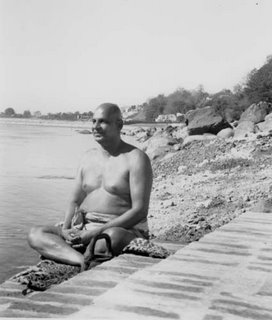
Meditation is like a gateway leading from normal day-to-day awareness to a higher state of consciousness. Swami Sivananda believed that devoted and deep meditation was the surest way to the deepest experience of one's essential being. Apparently in his early days of spiritual practice he was meditating eight, ten or maybe even twelve hours a day.
Meditation begins with interest-being very interested in going beyond the mind, and interest in wanting to know what is ultimately true. Or, the practice could start with a more humble interest: "Let me feel a bit of peace." According to Gurudev whatever the starting point, meditation needs to be carried on regularly and as often each day as is possible. No one ever said meditation would be easy! Arjuna said to Krishna in the Bhagavad Gita that, "I find the mind to be as hard to control as the wind." Sri Krishna assured Arjuna by saying, "The mind can be controlled through dispassion and repeated practice." Swami Sivananda was a fountain of encouragement and inspiration. "Never despair," he would say. He knew that meditation would provide great rewards for the devotee who persevered.
Meditation is one spiritual practice, which has a very widespread appeal. On one hand the modern man takes up to meditation for protecting himself from the ill effects of his life style of hurry, worry and curry (fast food and spices). On the other hand, 'meditation is a universal common process which unites the entire world fraternity of spiritual seekers' (Swami Chidananda); and so, all the seekers practise it. Meditation is spiritual practice (sadhana) common in various paths of Yoga, common in major religions and faiths. So there are different types of meditation to suit an individual sadhaka's temperament and sadhana.
"Just as you require food for the body, so also you require food for the soul in the shape of prayers, japa, kirtan, meditation, etc. The food for the soul is more essential than the food for the body." (Swami Sivananda). Meditation, as such, has become a part of daily routine of all those who have some concern for their soul, who are conscious of their long-term welfare - their spiritual ascent.
Maharshi Patanjali propounded the eight-stage Raja Yoga in his well-known sutras of Yoga Darshana. The sixth rung of Raja Yoga is dharana (concentration), and is followed by dhyana (meditation) and samadhi. Though a very large number of people are eager to know about meditation and understand it properly, very few of them might have studied this extremely difficult text. We have tried to explain in a lucid manner various aspects of meditation, namely:
1) Meaning of the concepts of concentration and meditation,
2) Where to concentrate?
3) Pre-requisites of Meditation,
4) How to Meditate?
5) Practical Hints,
6) Obstacles to Meditation,
7) Benefits of Meditation,
8) Experiences in Meditation, and
9) Indicators of Progress in Meditation.
Swami Sivananda Saraswati
1 comment:
Nice one! but i would like to know more about meditation! how to do it? and what are the practicle hints..and how do we know we are on a right track.. so kindly post some more information on Meditation. Thanks Kanika
Post a Comment